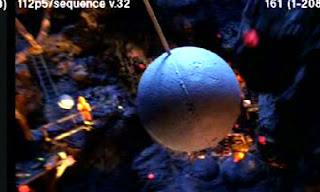--Thanks to Courtney at Artist Daily for spotlighting this post in on Artist Daily--
For the last couple of years, Google has had an image search option called “visually similar.” This locates images that are related by their abstract qualities, rather than their associated keywords.
For example, here’s a painting from Dinotopia: Journey to Chandara called “Irish Elk,” showing an extinct giant deer in a high mountain landscape. The colors are yellow ochres and browns, along with pale blues. There are no greens and hardly any reds.
Google sifts through millions of images on the web searching for other pictures with related image attributes, and presents those that it finds "visually similar." In this case, the images all have the same basic color gamut, a cluster of warm colors combined with grays and blues.
Presumably it selects other attributes, such as gradation, complexity, texture, and shape. Other visually-similar programs such as
Piximilar do the same thing.
In the previous example, what I found surprising was that, except for the helicopter and the dog, the results are all food ads. Why food ads? I'm guessing that the curving vignette shape surrounding the busy warm texture associated my picture with the curving shapes of plated food.
Here’s a sketch that I did with marker pens, a high contrast rendering of a man at a podium.
Google’s search program yielded results with dark silhouettes (not surprising) but the subjects are mostly clothes that are symmetrical and laid out flat. I find this surprising. Why clothes? Why symmetrical?
Here’s another Dinotopia painting, a stone monument at dusk, painted in brown tones, with a golden sky behind and a few cool or gray notes for contrast.
What does Google’s algorithm think is similar? A lot of interior scenes. Why interiors? Why so few outdoor scenes or so few paintings? Perhaps the particular color ranges I chose for my gamut happen to match those of indoor photos with white balance problems.
I find it fascinating that the results cluster around specific families of subject matter that are so different from the source image. Google explain exactly how their algorithm works, but it's fun to guess at it.
Anyway, searching for visually similar images is a great way to see our own color schemes from a fresh perspective. To use it, go to Images.Google.com and press the little camera button in the search window. You can upload any image from your computer, including one of your own paintings in progress, or drop in a URL address of an image you found on the web.
----------
LINKS















































